|
Our
film opens with plaid-clad outdoorsmen
Ivan Marx waxing on about that what we are about to
see is both true and authentic. And to prove
this point, we're first entreated to
several sequences of Marx tracking down
and killing some renegade bears -- but
only the guilty bears, mind you, not the
innocent ones (--
but I point out most of the bears were not
given proper due process), then
he's off capturing a cougar for a zoo
exhibit, and finally, a javelina is run
down and hog-tied for some diabolical
college experiment. With his great
outdoorsmen street-cred now firmly
established, Marx is brought to Alaska to
track down a rogue Kodiak that's been
depleting the local cattle population.
When Marx proves the bear innocent (--
lucky bear), the rancher claims it
never was a bear to begin with but a
Bigfoot that was killing off his herd. A skeptical
Marx had heard the legend of this creature
before, dating back some 700 years, and
the Native American tales of Stickmen and
Oh-man and Sasquatch -- verified,
somewhat, with some native etchings of a
creature with big hands and massive
clod-hoppers that, according to folklore,
had a bad habit of raiding villages and
stealing children.
Intrigued,
but still unconvinced, Marx continues
jumping around the country for various
jobs, and with each successive stop, finds
more and more evidence of this mysterious
creature -- mostly foot and hand prints,
and some coarse hair that he sends off for
testing at some undisclosed lab. The
hair-test results are in before Marx goes
out on his next job -- another guilty
bear, I guess -- and the tests reveal that
whatever left the prints and hair wasn't
human; species unknown. His skepticism
slowly devolving into apprehension, Marx
finds the bear he's been looking for dead,
it's neck snapped, surrounded by the
telltale footprints. Convinced now that
the creature really does exist, Marx sets
out to separate fact from fiction, and,
come hell or high-water, capture the beast
-- on film...
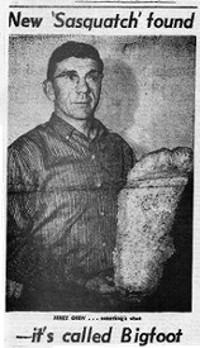 It
was back in 1955, while hiking up Mica
Mountain somewhere in the Rockies of
British Columbia, when William Roe had an
encounter with "a creature between
six and seven feet tall that was hairy all
over, had large breasts, a Negroid-shaped
head, and walked on two legs." This
was the first widely reported North
American sighting of a Sasquatch since the
world became yeti-addled when Sir Edmund
Hillary brought tales of an Abominable
Snowman back with him after he conquered
Mount Everest. But it wasn't until about
two years later, when several tracks of
large, humanoid footprints were found in
the soft loam along the logging trails
around Bluff Creek, California that the
notion of Bigfoot was born. And it was these
very same tracks that later brought Roger
Patterson and Bob Gimlin to the area in
1967, where they managed to capture what probably
is the
most infamous 16
seconds of footage ever committed to
film; and with that footage, the legend of
Bigfoot absolutely exploded into the
national consciousness, creating a
voracious appetite for more evidence that
a lot of folks were happy to oblige --
some more reputable than others. It
was back in 1955, while hiking up Mica
Mountain somewhere in the Rockies of
British Columbia, when William Roe had an
encounter with "a creature between
six and seven feet tall that was hairy all
over, had large breasts, a Negroid-shaped
head, and walked on two legs." This
was the first widely reported North
American sighting of a Sasquatch since the
world became yeti-addled when Sir Edmund
Hillary brought tales of an Abominable
Snowman back with him after he conquered
Mount Everest. But it wasn't until about
two years later, when several tracks of
large, humanoid footprints were found in
the soft loam along the logging trails
around Bluff Creek, California that the
notion of Bigfoot was born. And it was these
very same tracks that later brought Roger
Patterson and Bob Gimlin to the area in
1967, where they managed to capture what probably
is the
most infamous 16
seconds of footage ever committed to
film; and with that footage, the legend of
Bigfoot absolutely exploded into the
national consciousness, creating a
voracious appetite for more evidence that
a lot of folks were happy to oblige --
some more reputable than others.
Enter
amateur filmmaker, naturalist, and
self-proclaimed Bigfoot expert Ivan Marx.
Marx claimed his first encounter with
Bigfoot was back in 1951, when he found his
first set of footprints around Dead Horse
Summit in northern California. And he also
claims to have snagged his first Bigfoot
photos several years later while hunting
cougar in Nevada in 1958. And it was about
the same time the Patterson footage was
making waves when Marx found the dubious Bossburg
Prints, which showed an
"arthritic deformity," giving
them an air of authenticity. Then in 1973,
Marx received a call from a train engineer,
who claimed that his engine had clipped
one of the creatures in the same area east
of Bossburg, Washington, near the Canadian
border. (All of this is depending
on which version you hear. Other accounts
say a man in a pick-up hit the creature.)
It wasn't a fatal collision, however, and
the creature crawled away. Marx got the
general location, found a blood trail, and
with his wife, Peggy, tracked the injured
beast for several days -- and finally
overtook the crippled creature and managed
to not only get the encounter caught on
film, but also managed to snap off several
still-pictures before it limped off into
the trees and disappeared.
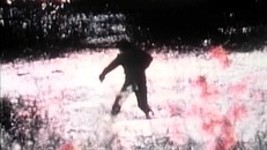
It
was this footage, and several more alleged
encounters that Marx filmed in Alaska,
that formed the backbone for 1976's The
Legend of Bigfoot.
Coming on the heels of Charles B. Pierce's
highly profitable The
Legend of Boggy Creek, a tale of a
bayou Bigfoot that terrorizes the folks
around Fouke, Arkansas, producer Marx and
director Harry Winer used that film as a
template, splicing together about two
decades worth of nature stock, punctuated
with a smattering of "authentic"
Bigfoot footage to give it some pop.
The
search to get to this footage was a long
an arduous one, though, with several false
leads, hoaxes, and tantalizing glimpses to
keep trailing narrator Marx -- and us --
along for the ride. But then suddenly,
Marx finds some deformed footprints, and
while tracking them, catches up with what
left them! And here, finally, we get to
see some clear footage of Marx's Bigfoot
-- that I assume was the footage of the
creature hit by a train, but here, Marx
claims that it has polio. Whuzzawhat?
Claiming the footage was confirmed to be
real by several experts, Marx scoffs at
the detractors and searches for more
evidence to prove these doubters wrong.
And that's basically how the rest of the
film plays out, with Marx gone Melville,
looking for his personal white whale. And
as a viewer, as we watch Marx spout off
some cock-eyed theories about the
Bigfoot's migratory patterns, you have to
wonder if our expert has been out in the
woods a little too long and is starting to
get a little barmy in the old brainpan.
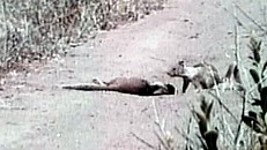
As
evidence, your honors, take a look at that
whole, and
embarrassingly long, law of nature
sequence, where Marx uses a mortally
wounded squirrel, stalked by an
ever-circling chicken hawk, to illustrate
that survival is the only law a Bigfoot
has to abide by. Whuzzawhatthe@#%*?
Next,
things continue to unravel with a visit to
Alaska to see Yukon Frieda and her gallery
of Bigfoot paintings, where Marx gets a
tip that the local Indians have a legend
about "a friend" who returns all
who die out on the frozen tundra to
be buried with their own kind. When
Marx asks them where he can find this friend,
the natives say to look for him in The
Land of Shining Eyes. (Isn't
that near Skagway?) But before he
embarks, Marx is taught a ritual song to
be sung during the next full moon that
will guarantee a sighting of the glowing
eyes of Bigfoot. This proves too goofy
even for Marx, who refuses to play along;
but after several days pass with no
sighting, he breaks out the old tom-tom
and whacks away. Sure enough, lured by
this siren call, something flashes
its high-beams over a nearby hill -- and
with that sequence, we've quickly taken a
long walk off a terminally-short credulity
pier.
Even
with all of these sightings, Marx still
has no solid proof of Bigfoot's existence.
And as our nature-boy gives in to despair,
he goes out for one final look before
chucking it in and just happens to stumble
upon not one, but two, Bigfoot splashing
around in a nearby creek! Watching these
creatures at play, Marx seems to come to
terms with the fact that he may never have
all of the answers to his questions about
Bigfoot. Content in the fact that he no
longer cares about such questions, he will
instead bask in the sheer wonderment of
these mysterious creatures.
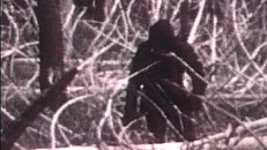
The
End
Often
confused with the similarly themed Sasquatch:
The Legend of Bigfoot,
in which another expedition of experts
head off into the wilderness to track down
some rock-chucking Sasquatch, The
Legend of Bigfoot is
fairly effective as a documentary. Sure, it's
probably a tad too long, and too
repetitive in spots, but Marx has a real
eye for scenery, he isn't shy about
getting up close and personal with the
animals, and he comes off as a rather
affable -- okay, sometimes irascible,
narrator. It's just too bad that all of
his "actual" Bigfoot footage,
which is set-up brilliantly, allowing it
to creep up on us through the trees, is
about as convincing as three dollar bill
when the camera steadies and the creature
comes into focus.
Yeah,
big surprise, it's all bull#@*%.
Rumors
abound that Marx and his wife bought a
bunch of fur coats at a Goodwill before
his first Bigfoot pictures started to
surface. And the fact that when the
location of the footage is checked for
scale, the creature wasn't seven to eight
feet tall as Marx claimed, but about the
same height as his wife, Peggy. All the
disparaging comments and increasingly bad
rep in the Bigfoot community didn't seem
to matter as Marx became sort of a Bigfoot
media celebrity, appearing on several TV
shows, including an episode of You
Asked for It
-- where they developed some raw footage
and screened it for the audience, which
showed an albino Bigfoot frolicking in the
snow, and a Smithsonian documentary
narrated by Rod Serling that featured all
of Marx's footage and photos. And then
there's this, here, full-length feature
documentary, made to feed the resurgent
Bigfoot-mania sweeping the country in the
late 1970s.
I
was proud to be a part of that
Bigfoot-mania that gripped America back
then. And there's still a part of my
brain that houses an irrational fear of
this creature that surfaces and taps me
on the shoulder and says
"Booga-booga!" whenever I
watch any of these old mockumentaries,
and frankly, they still tend to creep
the living poop out of me. They don't
call it irrational for nothing, folks.
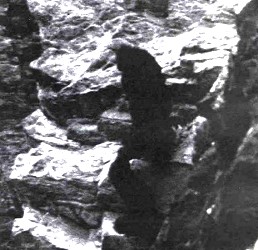 But
as time passed, more and more of Marx's
photos, footage and findings were called
into question and exposed as fakes (--
like the one on the right.) Even
his most staunchest defenders claimed most
of his evidence was probably staged, and
now, these days, with his reputation in
tatters, Marx is usually singled out as
the worst huckster to ever huck a hoax,
and blamed for setting the science of
crypto-zoology back several decades with
his shenanigans. But he wasn't alone. In
fact, it's been a bad couple of years for
Bigfoot enthusiasts. Those Bluff Creek
footprints found back in the '50s that
started all the initial hysteria turned
out to be fakes, too. The hoax was
revealed with the death of Ray Wallace in
2002; after which, in accordance with his
final wishes, Wallace's family came
forward with the molds and rubber casts
used to make all of the fake prints. And
unfortunately, if we follow the fruit of
this poisoned tree, that probably means
the much contested Patterson footage, shot
in the same area, and corroborated by several
footprints that bear a striking similarity
to Wallace's forgeries, is cast into even
further doubt. But
as time passed, more and more of Marx's
photos, footage and findings were called
into question and exposed as fakes (--
like the one on the right.) Even
his most staunchest defenders claimed most
of his evidence was probably staged, and
now, these days, with his reputation in
tatters, Marx is usually singled out as
the worst huckster to ever huck a hoax,
and blamed for setting the science of
crypto-zoology back several decades with
his shenanigans. But he wasn't alone. In
fact, it's been a bad couple of years for
Bigfoot enthusiasts. Those Bluff Creek
footprints found back in the '50s that
started all the initial hysteria turned
out to be fakes, too. The hoax was
revealed with the death of Ray Wallace in
2002; after which, in accordance with his
final wishes, Wallace's family came
forward with the molds and rubber casts
used to make all of the fake prints. And
unfortunately, if we follow the fruit of
this poisoned tree, that probably means
the much contested Patterson footage, shot
in the same area, and corroborated by several
footprints that bear a striking similarity
to Wallace's forgeries, is cast into even
further doubt.
Do
I believe in Bigfoot? Well, I like to
believe in the idea of Bigfoot, and
lake monsters, and the Bermuda Triangle. I
like the idea that there's still
some stuff out there that we can't
explain. And the more people debunk them
with irrefutable evidence and hard facts,
confident -- most times arrogant, in their
science, calling us idiots for believing
in such nonsense, I'll only stubbornly
believe in them more; and I also get all
warm and fuzzy knowing these ass-hats have
no clue how a bumblebee or a
hummingbird can fly.
But
fly they do.
|